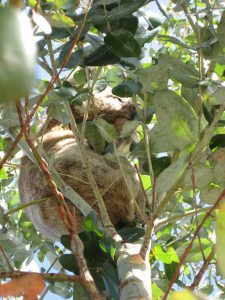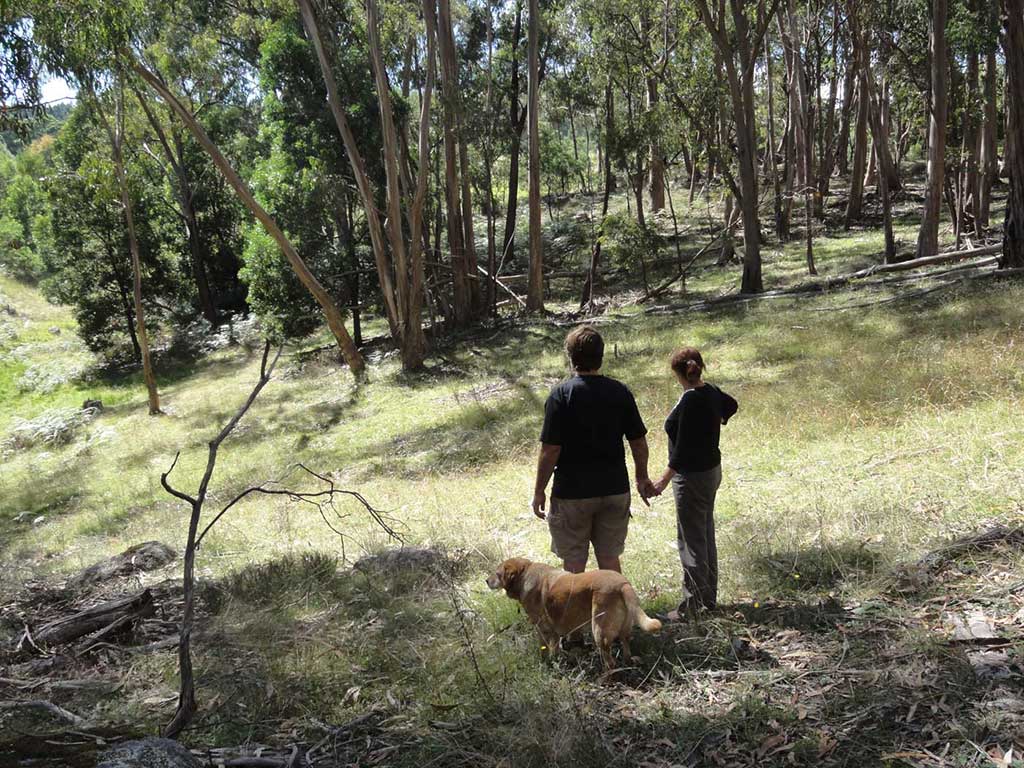“The sun, with all those planets revolving around it and dependent on it, can still ripen a bunch of grapes as if it had nothing else in the universe to do.” Galileo
During late spring, when the Eastern Brown and Tiger snakes come out from winter hibernation to find a mate and warm their cold skins in the full sun, we must tread firm and loud – for they are deaf creatures and only feel our presence by vibrations on the ground.
A lot of palaver is heard as we stomp the course to the stream where we kick off our rugged boots to dip hot feet in the running water. I do not venture into these regions alone but am still ever mindful the native snakes may also be inhabiting our garden, so I move with care, listening for a slithering sound on warm grass, or intuit their presence by a log or perfect hiding place.
 It is with some reservation that I agree to walk to the stream with Harry in the snake-optimum months: as if dodging native bees, biting mosquitoes, jumping fire-ants and active spiders were not enough to dampen his trekking spirit, we walk an easy kilometre to the creek, not parting grip from Harry’s hand, as I trot close to his side.
It is with some reservation that I agree to walk to the stream with Harry in the snake-optimum months: as if dodging native bees, biting mosquitoes, jumping fire-ants and active spiders were not enough to dampen his trekking spirit, we walk an easy kilometre to the creek, not parting grip from Harry’s hand, as I trot close to his side.
Tread Lightly
What we treasure most is how the ordinary is the extraordinary. Life by the creek bed is astounding, where my fear is replaced with reverence for the miniature world busy surviving the rigors of a changing environment. If we are really lucky, and tread lightly, we may find a rare orchid known as Austral Ladies’ Tresses (Spiranthes australis) springing up in marshy patches beside the creek bed.
The flowers burst forth during the summer months, and what is so stunning about this orchid is its bright pink flowers edged with a white frilly lip that wind around in a perfect spiral from a single stem. Harry captures the image on macro-setting on a camera so I can admire her beauty up close.
We pick our way over fallen branches, heading a little downstream to the watering hole where a carpet of variegated lichens covers granite boulders of all sizes. They form a spongy soft towel inviting us to lie down, and the sound of water playing over rocks slowly stills our conversation. The moment is filled with listening to the heartbeat of the bush.
I tease away a small patch of fibres of the lichen clinging to the rough surface, fascinated to feel its mossy structure. Lichen does not require a food source other than light, air, minerals and the moisture it catches from showers of rain. Lichens contain an acid that eats away at the rock surface so that in time, the huge granite boulders eventually disintegrate and turn into more soil for the forest floor.
Tea-tree, Nature’s balm
We dip our feet into the cool stream. The water carries a brownish oil – the sap from surrounding tea-trees. This is where my knowledge based on Aromatherapy practice informs encyclopedic professor-google about the healing properties of this remarkable oil.
The indigenous Bundjalung people of eastern Australia used various parts of the tea-tree plant in traditional medicine. The crushed leaves produce oil that we use today as an inhalation for coughs and colds (but must not be used internally). 
This highly pungent oil is not only a handy antiseptic way out here in remote country, but carries healing properties within tiny molecules that work as an antibacterial and antifungal oil. The bubbles frothing naturally by our feet enliven our spirits – refreshed and invigorated, we leave the creek bed and pick our way slowly back to the cabin through the forest of dry woods and wattles, dense bracken and tall native grasses.
Sharing the Harvest
 Back in the enclosed garden, Harry and I tend to our small collection of fruit trees, grape vines and berries. Weeds grow like giant shrubs in our absence and one of my tenacious practices is trying to keep the vegetable patch free from these equally stubborn plant intruders. Then there is my repellent garden song, sung in the key of ‘F’ accompanying a new planting of seeds, that a harvest of some sort will be left intact after the possums, wombats, wallabies and bird life have feasted on their share in our absence.
Back in the enclosed garden, Harry and I tend to our small collection of fruit trees, grape vines and berries. Weeds grow like giant shrubs in our absence and one of my tenacious practices is trying to keep the vegetable patch free from these equally stubborn plant intruders. Then there is my repellent garden song, sung in the key of ‘F’ accompanying a new planting of seeds, that a harvest of some sort will be left intact after the possums, wombats, wallabies and bird life have feasted on their share in our absence.
With each visit, I dart around the garden, brush away the soil with impatient fingers, and if any vegetables have remained on the vines, Harry and I sing ‘Hallelujah’ and celebrate with much rejoicing – and bottle the fruit or make sweet preserves before the wild life discover our windfall!
In winter months, a decent supply of hot water is as  valuable as gold out here beyond the black stump. A pot of hot water can be the result of years of planning and mutual management. A day to collect and chainsaw fallen logs into the right size pieces that fit the fire box inside the cabin. Another day to split, stack and store the wood off the damp ground in neat interlocking rows in the woodshed to keep it dry through the sometimes wet winter months.
valuable as gold out here beyond the black stump. A pot of hot water can be the result of years of planning and mutual management. A day to collect and chainsaw fallen logs into the right size pieces that fit the fire box inside the cabin. Another day to split, stack and store the wood off the damp ground in neat interlocking rows in the woodshed to keep it dry through the sometimes wet winter months.
A year’s firewood has to be stored in advance so there is always good burning fuel in store. Then once the wood has cured and dried, dozens of trips to and fro the wood shed to cabin are stepped out, bringing bags loaded with blue gum chunks into the cabin to burn in the Jotul stove. Water can now be brought to the boil, which takes half an hour, and only then is hot water produced for washing dishes. If we are feeling smug about our stack of dry wood, I can indulge in washing my hair!
On special occasions, we light the wood  fire underneath the outdoor bath tub and sit sipping champagne, watching the stars decked out in all their glory. Harry describes the Milky Way from the Pleiades to the Coal Sack in great detail as I also have night blindness and am lucky to see the flames of the wood rising higher under the bath. As the night progresses, the water gets hotter, charging our cheeks with colour!
fire underneath the outdoor bath tub and sit sipping champagne, watching the stars decked out in all their glory. Harry describes the Milky Way from the Pleiades to the Coal Sack in great detail as I also have night blindness and am lucky to see the flames of the wood rising higher under the bath. As the night progresses, the water gets hotter, charging our cheeks with colour!
Awoken from Dreamtime
I hear Harry moving about the cabin, preparing a delicious pot of percolated coffee. Nev smells something delicious too and springs off the veranda, his brown eyes alight, his tail wagging. My ‘dreamtime’ is interrupted by the stirrings of my companions and I move from the veranda, now drenched with sunshine to scratch around with happy hands and plant another seed, another bulb, a hopeful fruit pip.
And as the seasons come and go, we too return like boomerangs to the beauty under granite skies of the Australian bush.
Note: this story, Under Granite Skies first appeared on a US blog when I was invited to write a piece for travel photographer, Meg Pier for her guest room in 2012.
You can view the first part here
© 2013 Maribel Steel
Photographs: © 2013 Harry Williamson & Jenny Morse


